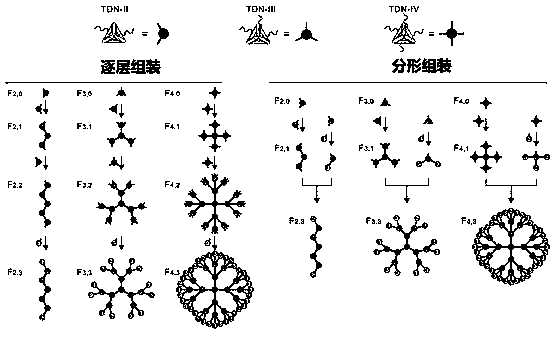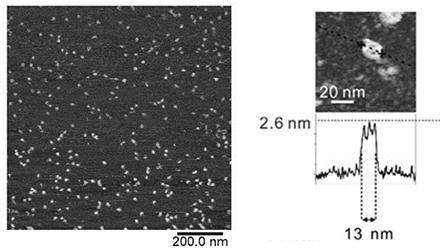Multi-color fluorescent probe based on DNA nanostructure as well as preparation method and application of multi-color fluorescent probe
A technology of fluorescent probes and nanostructures, which is applied in the field of multicolor fluorescent probes based on DNA nanostructures and its preparation, can solve the problems of luminescent properties (uncontrollable color and intensity, low number of fluorescent probe codes, etc.), and achieve good results. Biomedical application prospects, the effect of good biocompatibility
- Summary
- Abstract
- Description
- Claims
- Application Information
AI Technical Summary
Problems solved by technology
Method used
Image
Examples
Embodiment 1
[0045] The present invention provides a multicolor fluorescent probe based on DNA nanostructure and its preparation method and application. Firstly, the preparation of DNA tetrahedron includes the following steps:
[0046] Dissolve all DNA in Q water, measure the absorption of single strands at 260 nm by an ultraviolet spectrophotometer, and quantify the concentration of all single strands of DNA to 100 μM. Mix equal amounts of four single-stranded DNAs for preparing DNA tetrahedrons in TM buffer (10 mM Tris-HCl, 5 mM MgCl 2 , PH 8.0), the final concentration of single-stranded DNA is 1 μM. Keep the temperature at 95 ℃ for 10 min in the PCR machine, then quickly lower the temperature to 4 ℃, and keep it at 4 ℃ for 10 min to prepare the DNA tetrahedron. Then, 8% polyacrylamide electrophoresis and AFM were used to characterize the DNA tetrahedrons. The electrophoresis running conditions were 120 V for 120 min. The morphology of DNA tetrahedron was characterized by AFM.
[0047] Res...
Embodiment 2
[0049] The preparation of high-order DNA tetrahedral self-assembly structure includes the following steps:
[0050] The DNA tetrahedrons modified with complementary arm chains were mixed according to the assembly molar ratio of 1:1, and incubated at 37°C for 2h to obtain the first-generation high-order DNA tetrahedral self-assembly structure (G1). Then, the second generation (G2), third generation (G3), and fourth generation (G4) high-order DNA tetrahedral self-assembly structures were synthesized by incubating at 37°C for 2 h by layer-by-layer assembly or fractal assembly. The assembly rules of high-order DNA tetrahedrons are as follows. From the central tetrahedron a-T0 as the assembly center, each additional layer represents the generation of a new generation of high-order structures. The n-1th generation tetrahedral high-order structure a-Gn-1 with arm chains is 3×2 (n-1), and the nth generation is obtained by hybridization with tetrahedrons with complementary hybrid arm chai...
Embodiment 3
[0059] Using the structural characteristics of the high-order DNA tetrahedral self-assembly structure, we further studied whether it is possible to construct multicolor fluorescent probes without crosstalk between adjacent molecules and quantifiable fluorescence intensity through the labeling of fluorescent molecules. Each DNA tetrahedron in the high-order DNA tetrahedron self-assembly structure has a site for labeling fluorescent molecules, so each tetrahedron can label 4 fluorescent molecules. We choose Alexa488, ROX and Cy5 three kinds of fluorescent molecules to construct multicolor fluorescent probes. For the F3,2 structure, 28 fluorescent molecules can be labeled.
[0060] Fluorescence spectra of the constructed fluorescent probes were collected using Edinburgh FS920 fluorescence spectrophotometer. The concentration of all tested samples was 10 nM. Alexa 488 excitation wavelength is 488 nm, spectral reception range is 495-590 nm; ROX excitation wavelength is 588 nm, spect...
PUM
 Login to View More
Login to View More Abstract
Description
Claims
Application Information
 Login to View More
Login to View More - R&D
- Intellectual Property
- Life Sciences
- Materials
- Tech Scout
- Unparalleled Data Quality
- Higher Quality Content
- 60% Fewer Hallucinations
Browse by: Latest US Patents, China's latest patents, Technical Efficacy Thesaurus, Application Domain, Technology Topic, Popular Technical Reports.
© 2025 PatSnap. All rights reserved.Legal|Privacy policy|Modern Slavery Act Transparency Statement|Sitemap|About US| Contact US: help@patsnap.com



